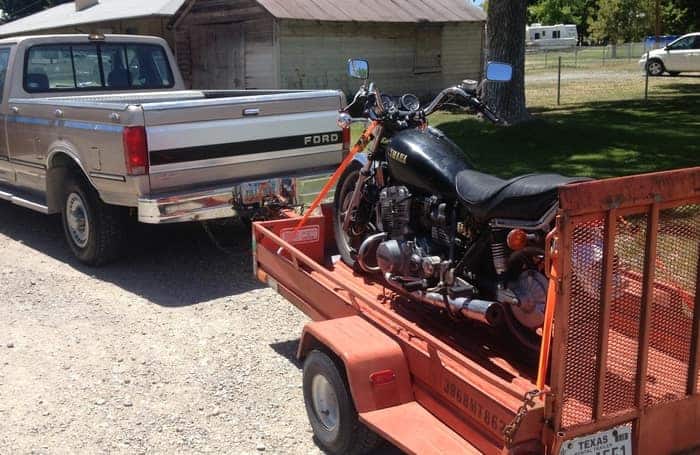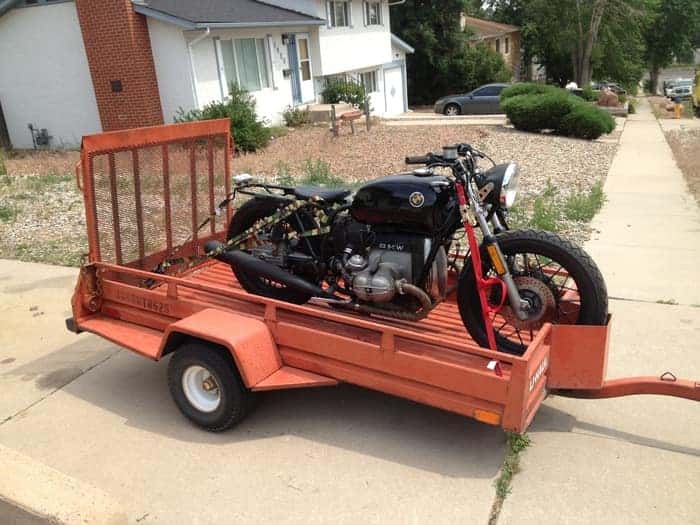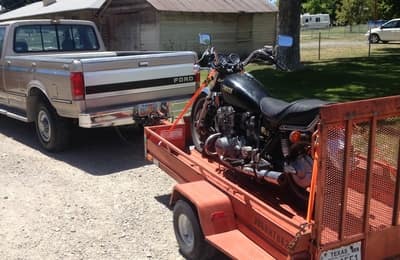
There are many reasons why a motorcyclist may need to trailer their motorcycle some distances. Whatever the reason may be, motorcycle owners may be a bit wary about doing so because of possible damage that could happen to their bike during their journey.
It’s important to take the proper steps beforehand to secure the motorcycle in the first place and ensure it’s stability. There are several ways you can protect the cosmetic components of your motorcycle that only take a short mount of time to do.
How do you protect a motorcycle from damage on an open trailer? To keep a motorcycle protected on an open trailer, it’s important the motorcycle is securely fastened to the trailer with chocks and straps. Using a cover can cause more damage rather that protection, so use one to your discretion. Cover any holes or intake the motorcycle may have to keep any water or moisture out.
While there are a few easy ways to protect your motorcycle when hauling it on an open trailer, there are a few things you can do that can actually ruin it. I have trailered dozens of motorcycles countless times long distances and have been able to learn how to properly secure and keep a motorcycle safe while doing so. This is what I’ve learned.
Protecting Your Motorcycle On An Open Trailer
It can be a bit stressful when you have to haul a trailer behind your car. It can be especially nerve-racking when a motorcycle is involved on an open trailer.
Open trailers are an excellent way to transport large items. They’ve proven to be a safe and effective way to get something from point A to point B. You just need to make sure you take the proper steps in preparation so your motorcycle is fully protected.
First and foremost, make sure you have motorcycle insurance. If you’ve just bought the motorcycle you’re transporting, you can easily make a phone call and get it insured quickly. Having comprehensive insurance especially will cover any damages done to the motorcycle while in transport. You can click here to see a list of motorcycle insurance agencies near you and do a rate comparison that meets your budget.
Once you get the motorcycle on the trailer, the very first thing you’ll need to do is strap it down tightly. Make sure you place the motorcycle in a spot on the trailer where the weight is distributed evenly, meaning it’s not parked too far forward or too far back. You should always use at least four straps when fastening down a motorcycle to a trailer.
There are only three parts you should ever attach the straps to on a motorcycle when securing it to a trailer. Always use points of the frame, the front shocks, and/or the handlebars. Do not attempt to attach the straps to anything else such as wires, gas tank, foot pegs, etc. that could easily come off with enough force.
The front two straps can easily be attached to the base of the handle bars, the two front shocks, and/or the very front part of the frame. Hook and tie the tow straps at the highest point possible while still being as close to the frame as possible. In other words, don’t tie the straps at the end of each handle bar. Make sure to attach the other end of the straps as low as possible on the open trailer.
The same rules apply with the back side of the motorcycle. I usually connect the two straps on the back of the frame, usually where the seat goes. The straps should generally be pulling away from each other to create resistance in all directions and keep the motorcycle from moving in any direction.
Never fully compress the shocks (or bottom out) when tightening the straps. A good rule of thumb is to never compress more than about 50%. Tie down and secure any slack left in the straps so they don’t flail around and hit your motorcycle or other passing vehicles.

Properly strapping down your motorcycle to a trailer is the single most important thing you can do to protect it and others around you. Once you have that completed, you’ll then want to put some chalks down in front of the front tire and behind the back tire.
I don’t recommend using chocks that move as they can easily get bumped away and even fly off and hit another vehicle. I recommend ones that fasten down to the trailer. Click here to see the specific chocks I recommend in my list of ways to tow a motorcycle.
If you know it’s going to be raining or snowing, or if you want to be extra cautious, plug up any open holes on your motorcycles such as exhaust and intake. This is especially important if you have pod filters instead of an air box.
You can use simple things such as old socks or wash cloths but just make sure you remember to take them out before starting the motorcycle. This will prevent water from getting in places it shouldn’t.
Your next instinct may be to put a cover over the motorcycle to prevent rocks and other debris on the road from hitting your motorcycle. Using a cover during a high speed haul can actually cause more damage than protection because the wind will make the cover rub all parts of your motorcycle. And with dirt getting up inside, that can be especially dangerous for your cosmetics.
If you plan on putting a cover on your motorcycle, make sure to tighten every part of it down tightly so none of it flaps around in the wind. This can be a safe and effective way to protect your motorcycle if it is done right, but a lot of people have had success going without a cover.
You may also want to try using some saran wrap instead of a cover. You can cover parts of the motorcycle that can easily become damaged such as rear view mirrors, gauges, seats, tank, etc. People have also successfully completely wrapped their whole motorcycle in saran wrap that yielded excellent results. It’s a great way to protect your bike.
If you’re especially worried about the motorcycle tank getting scratched or dented, you can simply detach it from the motorcycle and put it in a cushioned place inside your car. You’ll need to make sure the gas is completely emptied beforehand.
The last thing I’ll mention is the usage of mud flaps on your vehicle. Most of the rocks and debris that flies up and hits a motorcycle comes from the vehicle that’s towing it. Mud flaps can greatly reduce the amount of debris and provide extra protection for your bike.
You’ll also want to make sure to stop every 50-75 miles to inspect the motorcycle and ensure the tow straps are doing their job. Make the proper adjustments as needed if you’ve noticed your motorcycle has moved at all since your last stop.
Choosing The Right Trailer
Before placing a motorcycle on top of a trailer and hauling it away, you’ll need to make sure you have the right type of trailer to do the job safely. In particular, you’ll need to make sure the trailer has the right load capacity.
On average, most motorcycles weight about 400 pounds. You should be able to find the trailer’s load capacity somewhere on the frame. In general, if the motorcycle is able to easily fit on top of the trailer, chances are the trailer has the capacity to tow it.
Be sure to follow all traffic laws and make sure the trailer you use is functioning properly. If it isn’t, it could cost you a hefty ticket down the road. In most states, towing trailers need to have blinkers, brake lights, and have up-to-date registration.
Protecting Your Motorcycle When You Have To Stop For The Night
If you’re travelling a long distance that requires you to stop for the night, you may be wondering how to protect your motorcycle while it’s out in the open while you’re sleeping. I’ve run into this situation many times myself.
The biggest concern in situations like this is either someone touching and scratching up the bike or simply stealing it. If you have to stop for the night, you’ll want to make sure there is a cover over it that’s tightly fastened. Though this isn’t 100% effective in repelling hooligans, it does a pretty good job at keeping it out of site for potential damage.
Unfortunately motorcycles are a bit more susceptible to theft simply because they are smaller vehicles and easier to take. Make sure to use a disc lock alarm on your motorcycle at night while you park it. Click here to see the disc lock alarm I recommend in my list of suggested security for a motorcycle.
Damage Repair After Trailering
Don’t worry too much if you find yourself in the unfortunate event that you see damage on your bike once you get it home. There are plenty of remedies out there that will take care of most cosmetic issues.
The biggest cosmetic issue you’ll probably run into is scratches found on the tank. Any good quality automotive scuff removal kit should be able to take care of the job for you. You may need to repaint the tank if you have found some new dents on it. See my other article here for a tutorial on how to paint a motorcycle tank and what kind of paint to use.
Related Questions
Can you haul two motorcycles in one trailer? It is possible to haul two motorcycles at the same time, the trailer just needs to be big enough to do so. Make sure the motorcycles are at least two feet apart from each other. Follow the four point system described above and make sure the straps do not interrupt the other motorcycle and it’s straps.
Can you tow a motorcycle with a car? It is completely possible to tow a motorcycle with a car. You’ll need to know your car’s towing capacity, install the appropriate hitch, use the right kind of trailer, and understand the local laws and use the proper safety precautions. Click here to see my full tutorial on how to tow a motorcycle with a car.

